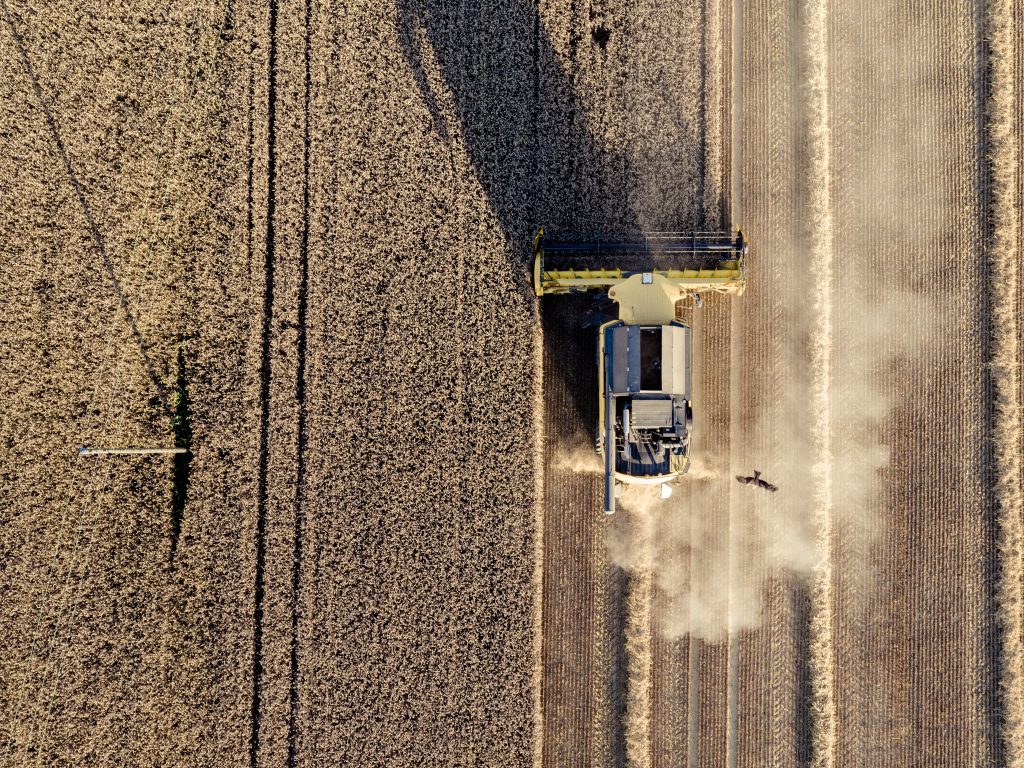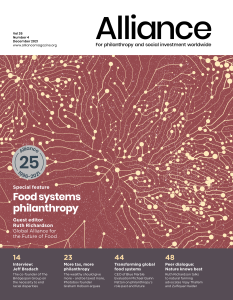The global food system accounts for around one-third of human-caused greenhouse gas emissions, according to the Food and Agricultural Organisation of the United Nations. From deforestation to cultivation to transportation, the many aspects of the food system together make a major impact on the environment and, as it stands, threaten climate goals. But philanthropic organisations stand in a unique position to fund positive change.
Making social investments in underserved agricultural communities can be one area where foundations can make an impact, but the problem, and therefore needed solution, is much larger. To limit climate change, foundations need to tackle systematic areas, like current livestock farming practices, with cattle being the top source of agricultural greenhouse gases globally, according to the University of California, Davis. The UN also finds that the livestock sector accounts for 14.5 per cent of human-caused greenhouse gas emissions.
‘There’s really no way we’re going to be able to hit our Paris climate targets without addressing the emissions from the industrial animal agriculture system,’ says Zak Weston, food service and supply chain manager at Good Food Institute (GFI), a nonprofit focused on alternative proteins, including plant-based meat, cultivated meat and fermentation.
Indeed, a study by Clark et. al, published in Science, finds that global food system emission trends currently put the Paris Agreement goal to limit the global temperature increase to 1.5°C out of reach; the 2.0°C target also appears likely unreachable, even if all fossil fuel emissions stopped immediately. Citing this study, GFI notes that alternative proteins could approximately cut total food system emissions in half through the end of the century.
Getting to this point, however, likely requires significantly more capital to fund everything from companies creating lab-grown meat to farmers who adopt more sustainable practices. In particular, the global food system likely needs a healthy dose of catalytic capital from foundations that can provide the patience and risk tolerance needed to jumpstart change.
This catalytic capital can overlap with what some foundations consider to be social investments, but generally what makes catalytic capital unique is that there’s often less financial return expectations and more flexibility.
Filling the funding gap
While investments into a more sustainable food system have been on the rise, foundations likely need to do more than tweak their investment portfolios.
From 2010-2020, alternative protein companies raised around $6 billion, with most of that coming in 2020, according to GFI. ‘But when you think about something as large as the global food system, and the effect that has, we need orders of magnitude more,’ says Weston.
In comparison to alternative protein funding, he adds, nearly 10 times as much has gone into electric vehicles and charging technology. Meanwhile, well over $100 billion in invested capital has gone into renewable energy such as solar, according to a GFI analysis of Pitchbook data.
There’s really no way we’re going to be able to hit our Paris climate targets without addressing the emissions from the industrial animal agriculture system.
‘It’s certainly not a bad thing that we’ve been putting a lot of money in electric vehicles or solar energy. And really, in fact, I think those are success stories and case studies that indicate that it’s totally possible for alternative protein projects to get the needed capital,’ says Weston.
Part of the funding gap can be explained from a technology standpoint.
‘I think what we’re seeing is an intersection of the technologies themselves maturing to the point where we can create better products. And we’re also seeing the intersection of the trend of consumers shifting and being more interested in the sustainability of their choices,’ says Weston.
He explains that the venture capital model has worked well for some early-stage alternative protein companies that have been able to go to market and provide significant returns.
‘But it’s poorly suited to some of these deep tech types of operations, where it’s going to take a long time to commercialise the technology. And it’s also poorly suited to investing in things like building a factory, for example,’ particularly in terms of debt financing to build out facilities versus taking equity stakes in consumer-focused companies. That’s where catalytic capital comes in, he says.

Global food system emission trends currently put the Paris Agreement goal to limit the global temperature increase to 1.5°C out of reach, according to a study in Science. Photo credit: Unsplash
The need for catalytic capital
Traditionally, foundations have had two general buckets for deploying non-administrative capital. One bucket is for grants, and the other is for investments.
In many cases, the investment bucket vastly surpasses that of grants, with the thinking being that investment returns from an endowment can then fund grants long-term, perhaps in perpetuity, rather than making a foundation so dependent on fundraising. However, that could leave a large portion of assets out of the equation in terms of making a positive impact.
‘If foundations solely focus on their five per cent annual distribution amount, the other 95 per cent is underleveraged for mission,’ says Elizabeth Carlock Phillips, executive director of the Phillips Foundation. The foundation does not specifically focus on food systems change but more broadly looks to where it can make the greatest social and environmental impact.
Phillips Foundation also aims to have a 100 per cent mission-aligned portfolio, something that it has been doing since 2014.
‘Moving the foundation toward a 100 per cent values-alignment strategy was a natural, intuitive decision for our board of trustees as stewards of 100 per cent of a charitable endowment. Focusing on the five per cent of assets distributed in grants didn’t seem to be a mathematically correct focus for our overall endowment value,’ explains Phillips.
It’s about ‘going where the market won’t go, like dairy farmers converting to low carbon or carbon-neutral farming practices.
Still, mission-aligned investing and similar strategies only go so far at times. Foundations also have an opportunity to use their capital as a catalyst for change, hence the term catalytic capital.
‘Phillips Foundation defines catalytic capital as leveraging one’s resources to catalyse change, while also helping to unlock additional capital. Catalytic capital is often also risk capital that stands in a gap to serve as creative financing for impactful initiatives, funds or organisations,’ explains Phillips.
Perhaps more than any other type of investor, foundations are often prime candidates to serve as catalysts.
‘From our journey over the last decade, we also believe the highest use of institutional philanthropic capital is to serve as risk capital. Governments cannot gamble with taxpayer dollars, so innovation is not inclined to thrive within public contexts. Then you have private investors and corporations which are still seeking to drive a financial bottom line for the most part. Institutional philanthropy is uniquely positioned to stand in the gap,’ says Phillips.
Catalytic capital can look different from investor to investor, as well as from deal to deal. Sometimes it’s about taking a little bit less return, like making a loan at a below-market interest rate. Other times it’s more about being more patient, as opposed to some private equity deals that have faster expectations for when an investment will start yielding returns.
Catalytic capital can also be part of a blended finance approach, where it’s used to bring in market-rate investment, thereby helping to bring about the full amount of capital needed to drive change.
‘In food systems, for example, we see that there’s a huge investment gap,’ says Adhiti Gupta, associate director of market acceleration at Convergence, a global network for blended finance. ‘There is not enough charitable capital in the world to fill that investment gap.’
Finding opportunities
In addition to areas like alternative proteins, the need for catalytic capital stretches far and wide.
It’s about ‘going where the market won’t go, like dairy farmers converting to low carbon or carbon-neutral farming practices. There’s no commercial capital that’ll go for that,’ says Tim Freundlich, founder and executive director, strategic development, at ImpactAssets, an organisation that specialises in facilitating direct impact investments via donor-advised funds.
While traditional investors might not hop on board right away, foundations often have the leeway to pursue catalytic investments as they see fit.
‘There are opportunities everywhere. Basically, if you look at a system, and your mindset is, where are the high leverage points of capital that can catalyse positive movement of the system in the way that we have decided it should go — that being more sustainable, more equitable, more carbon-neutral, more inclusive — then you start to craft into those gaps and solve problems,’ he says.
For example, ImpactAssets clients have made catalytic investments in companies like rePlant Capital and Iroquois Valley Farmland REIT, which help support organic and regenerative farming. Another example is Misfit Foods, which combines vegetables and seasoning with humanely raised meat.
If foundations solely focus on their five per cent annual distribution amount, the other 95 per cent is underleveraged for mission.
Similarly, at Convergence, Gupta shares how she also sees how foundations can play an important role in funding more sustainable agriculture in emerging markets, where credit risk may be higher than a bank would typically take on. And foundations can often take a flexible approach to support these types of farmers at different stages.
‘So they may give some early-stage grant support, just for the design and structuring [of a deal], and then they may follow it up with a repayable grant,’ she explains. ‘Or when the investment structure is put together, they might come in with a low-interest loan to then attract more capital. So I think foundations have that kind of flexibility that a lot of other investors don’t.’
Even if foundations don’t have many in-house resources to navigate this flexibility, finding opportunities for catalytic investments has also arguably become easier.
‘Many foundations turn to investment advisors, convening groups, and other networks to source catalytic deals. Many receive a ton of in-bound proposals and requests. There is also a reliance on peer recommendations, and in that way, it’s not that much different from the venture capital community,’ explains Marilyn Waite, managing director of Climate Finance Fund, a philanthropic platform that aims to mobilise capital for climate solutions, funded by the William and Flora Hewlett Foundation and housed at the European Climate Foundation.
Still, foundations may have to put in a bit of work to break down walls between grantmaking and endowment investing to instead find ways to make the most impact.
‘Every foundation is different and the journey toward mission alignment takes time. That said, we believe that foundations should be intentional with all the resources they steward, understanding that the traditional bifurcation of grants and investments is no longer a maximised approach,’ says Phillips. ‘It’s an exciting time for the field of philanthropy and impact investing. We are at an inflection point.’
Jake Safane is a freelance writer in Los Angeles who specialises in finance and sustainability.
Alliance magazine’s climate change coverage is supported by Fondation de France.
 Upcoming issue: Food and philanthropy
Upcoming issue: Food and philanthropy
Philanthropy spends billions on areas which are implicitly connected to food systems such as environment, climate, health, nutrition, and development but food issues are seldom explicitly addressed in funding strategies. Did 2021 prove to be the year when all that changed? This issue explores the ways in which philanthropy can help translate commitments made at the UN Food Systems Summit and COP26 into action and sets out a critical role for philanthropy in the future of food. Guest edited by Ruth Richardson, Executive Director of the Global Alliance for the Future of Food.
Subscribe today to make sure not to miss it!






Comments (0)